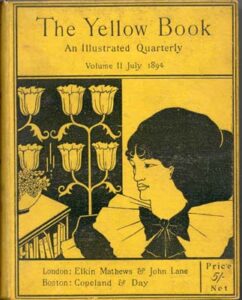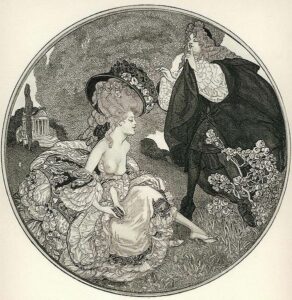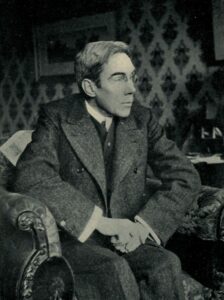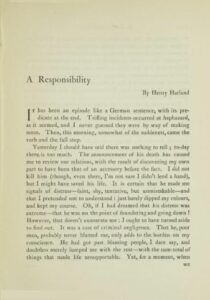Death in The Decadent Movement: Henry Harland’s “A Responsibility”
© Copyright 2019 Dararrtu Abdullahi, Ryerson University

Introduction
The Yellow Book, a British quarterly literary periodical with a print run from 1894 to 1897, was a magazine that was associated with the Decadence & Aestheticism movements. It was the leading journal of the 1890s, containing a variety of literary and artistic genres such as poetry, essays, illustrations, short stories, and replications of paintings. The fin-de-siècle magazines resembled a transitional period of the Victorian era, with the emergence of notable artists and literary writers uniting to produce an aesthetic publication departing from the academic scholarly writing of the 19th century. The Decadent Movement was the evolution of art and literature into modern society. It was an aesthetic ideology of valuing excess and artificiality, with human creativity challenging traditional values of logic alongside the natural world through social, political and artistic experimentation. This concept is evident in Henry Harland’s “A Responsibility,” which was strongly influenced by the notion of art imitating life by displaying his refusal of accepting an unfortunate event. In this short story, Harland receives the news that an old friend has passed away. He reminisces about the first time they initially met, describing his aura of mystery and sadness. It is later indicated that Harland’s friend had committed suicide, which left a burden on his conscious that perhaps he could’ve done something to prevent him from his demise.
Links to The Decadence Movement

The 1890’s little magazines introduced some important genres of contemporary writing; particularly the modern short story, fantasy literature, and New Women’s fiction. The British utilized the Decadence and Aestheticism movements which evolved into “A Total Work of Art,” referring to the highly stylized periodicals in content and appearance. It was an opportunity for artists to express themselves creatively, exploring the influence on readers through various craftsmanships; ultimately making it difficult for reviewers to define the periodicals accurately. They are described to be “disposable carriers of information,” meaning that each periodical served its own uniqueness, rejecting the notion of having a continuous theme by existing separately from one another. The Yellow Book’s periodicals featured a mix of realism, naturalism, and French-influenced Aestheticism. This offers insight into Victorianism and the modernity of The Yellow Book, which exemplifies the strengths and weaknesses of that time period. Elite writers began to represent moral and cultural decline, challenging the etiquette of the Victorian era by incorporating modern concepts that were considered unethical. Writers would rebel against social norms that were used as art to enlighten readers, discussing issues that were generally kept undisclosed because it would lead to recognition within the elite group of writers.
The Editor & The Author

Henry Harland is primarily remembered for his central role in fin-de-siècle London and editorship of The Yellow Book (1894-1897). He replaced Aubrey Beardsley after being dismissed from the job due to his affiliation with Oscar Wilde who was on trial for homosexuality during the 1890s. He was celebrated for being an elite writer, and generally known for delivering to the upper-class audience. Henry Harland’s contribution to The Yellow Book specifically helped the development of the short story as a genre, typically referencing artists struggling with poverty or aristocrats resisting the growing power of the middle-class. He reflects the preoccupations of fin-de-siecle artists, referring to the artistic and social elites being the last effort to compete against the increasing social mediocrity. The letters between Henry Harland and John Lane (publisher of The Bodley Head) reveal the intentions behind the progression of The Yellow Book. It is exhibited that Henry James’s literary personality had a major influence on Harland and Lane in the promotion of the magazine. He possessed a complicated image of himself, critics defining him to be “money hungry” and “obliging the worshipful.” In actuality, James was devoted to his art while unaffected by the demands of the market. He possessed a complicated image of himself, critics defining him to be “money hungry” and “obliging the worshipful.” In actuality, James was devoted to his art while unaffected by the demands of the market. He rejected the notion of established magazines and expressed that he was uninterested in writing material for the elite readership. He possessed a skill that readers could relate to him independently for his work, resulting in James being notable and praised for his contributions to The Yellow Book. Henry Harland and John Lane thoroughly discussed who is suitable to participate in The Yellow Book, being a periodical of its kind that was never produced before. The letters give insight into the close relationship between Harland and Lane, in addition to the tensions that arose when deciding the payments to the contributors. Henry Harland did not accept payments for his contribution of short stories to The Yellow Book, his reason being “for the love of The Yellow Book.” This gives an understanding of who he was as an author, linking this idea to his creative writing. It shows that he valued the beauty of art over financial gain, writing personal stories to identify with the readers of his pieces to demonstrate that mutual human experiences can be communicated through art.
Research Question
How does the combination of realism and culpability allow us to situate death as a universal concept that comments on fin-de-sièle Decadence and relates to other content in The Yellow Book? The topic of death is examined throughout “A Responsibility,” emphasizing the impact of realism and culpability on an individual. Henry Harland presents suicide through a viewpoint of regret, using his craft he conveys unbearable emotions that are openly therapeutic. He is battling his own conscience, and through the fin-de-sièle magazines, he artistically expresses his personal issues that may connect to his readers.
A Responsibility

When examining “A Responsibility,” it’s important to consider the magazine it was published in and the target audience of it. Published in Volume 2 of The Yellow Book, in July 1894, and was placed in the center of the periodical. There is a paratext after the short story, it’s of two naked women who seem to be looking through an opening of trees in a dark forest, irradiating the sunlight. The theme that’s interpreted throughout this entire magazine is uncertainty, a feeling of mystery that never disappears. The illustrations appear to reflect Harland’s mental images, giving the impression that his conscious is lost in a sphere of remorse. In the short story, he keeps reminiscing of his old friend Sir Richard Maistre, in which he just received the news that he passed away. However, later within the story, a note that was written by Maistre reveals that although not explicitly stated, it surely indicates that he committed suicide. Harland’s first reaction is to believe he could have prevented his demise, if only he stopped and acknowledged Maistre the last time they saw each other instead of walking past him. Admitting that the first encounter when they initially met Maistre came off a very sad and mysterious man, not to mention hesitant as well. Harland assumes he is ultimately the reason Maistre ended his life, describing himself to be ” an accessory before the fact” (Harland 103). These emotions of sorrow and culpability take over his mind, leaving him feeling accountable for Maistre’s passing. Death is a universal concept that is objectively inevitable. Harland learns to cope with this hardship through his craft to relieve emotional pain, gradually realizing it’s impossible to be in control of such an unexpected occurrence. The Decadent Movement is demonstrated through “A Responsibility” because it illuminates the text in a manner that situates realism to be the main factor in human creativity. Realism greatly affects our perspectives of the world, ultimately defining every individual’s meaning and purpose in life. The circumstances of our surroundings and the way in which we interpret them. Focusing on the aspect of emotionalism, realism intertwines with the ideas of truth and accuracy. The precision of translating life experiences into art is a complex task since it’s difficult to clearly articulate human feelings. Henry Harland forcefully expresses his emotions, therefore it’s evident that he was reluctant to disclose everything he was originally thinking. Death has the power to recall forgotten memories, overall having an effect on our well-being. Trying to navigate in the midst of confusion and betrayal will result in vulnerability, becoming subject to the constant thought of death. The preparedness of it can install fear into someone’s daily life, restricting them from maintaining a suitable lifestyle. Harland exhibits self-awareness, by knowing he was a significant individual within Maistre’s life. Keeping him alive through Harland’s perspective was “a responsibility” to him, although his suicide could in no way have been prevented. It’s an illusion that’s formed from guilt, it’s shown that he’s reliving hearing the disheartening news that constantly reminds him of the way he negatively thinks of himself. In correlation with realism, the mix of naturalism is also displayed within this text. Birth and death define life, it’s the most significant element of humanity. Henry Harland demonstrates the concepts of death and culpability exquisitely, through his writing he’s able to realize his mistakes and connects to his readers that’s overall heartfelt and sympathizing.
To Conclude…
The Decadent Movement greatly influenced the fin-de-siècle little magazines that utterly changed the outlook on 20th-century writing. It introduced new genres of contemporary writing that are heavily used in English literature, through having the ability to express ideas and opinions artistically. It encouraged the concept of innovativeness, to produce aesthetically pleasing written works that did not restrict writers and allowed them to be passionate and free. Henry Harland demonstrates the concepts of realism and culpability through a powerful short story, identifying with readers to mirror the purpose of The Yellow Book. By introducing The Yellow Book through fin-de-siècle decadence, it was able to be a momentous triumph that carried its significance into modern-day society. The periodicals turned imagined and creative ideas into a reality, possessing the potential to travel being utilized as an example of a new art form. The aesthetics from The Decadent Movement served an appreciation for the beauty of art, that previously left individuality unnoticed due to the high demand for academic scholarly writing. “A Responsibility” is a showcase of perseverance, interpreting obstacles as survival tactics. It’s proof that remarkable stories leave a meaningful purpose in writing, and once they’re written they travel solely in the world without the author.
Works Cited
Claes, Keonraad & Demoor, Marysa. “The Little Magazine in the 1890s: Towards a ‘Total Work of Art.” English Studies, vol. 91, no. 2, 2010, pp. 133-149. RULA, https://journals-scholarsportal-info.ezproxy.lib.ryerson.ca/details/0013838x/v91i0002/133_tlmit1tawoa.xml
Marcovitch, Heather. “The Yellow Book: Reshaping the Fin-de-siècle.” Literature Compass, vol. 13, no. 2, 2016, pp. 79-87. RULA, https://onlinelibrary-wiley-com.ezproxy.lib.ryerson.ca/doi/full/10.1111/lic3.12292
Beckson, Karl E. & Samuels Lasner, Mark. “The Yellow Book and Beyond: Selected Letters of Henry Harland to John Lane.” ELT Press, vol. 42, no. 4, 1999, pp. 401-405. RULA, https://muse-jhu-edu.ezproxy.lib.ryerson.ca/article/367243/pdf
Diebal, Anne. “The Dreary Duty’: Henry James, The Yellow Book, and Literary Personality.”Johns Hopkins University Press, vol. 32, no. 1, 2011, pp. 45-59. RULA, https://muse-jhu-edu.ezproxy.lib.ryerson.ca/article/416451
Bristow, Joseph. “The Fin-de-siècle Poem: English Literary Culture and the 1890s.” Indiana University Press. vol. 48, no. 4, 2006, pp. 771-773, Google Scholars, https://muse.jhu.edu/article/210043/summary
Images in this online exhibit are either in the public domain or being used under fair dealing for the purpose of research and are provided solely for the purposes of research, private study or education.
